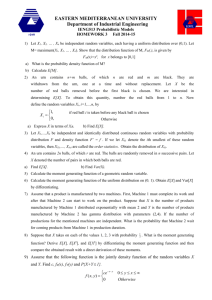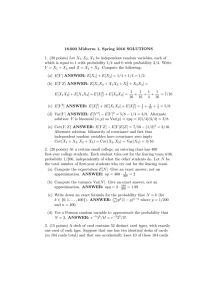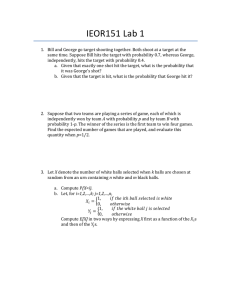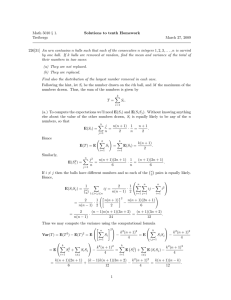Math 5010 § 1. Final Exam Name: −
advertisement
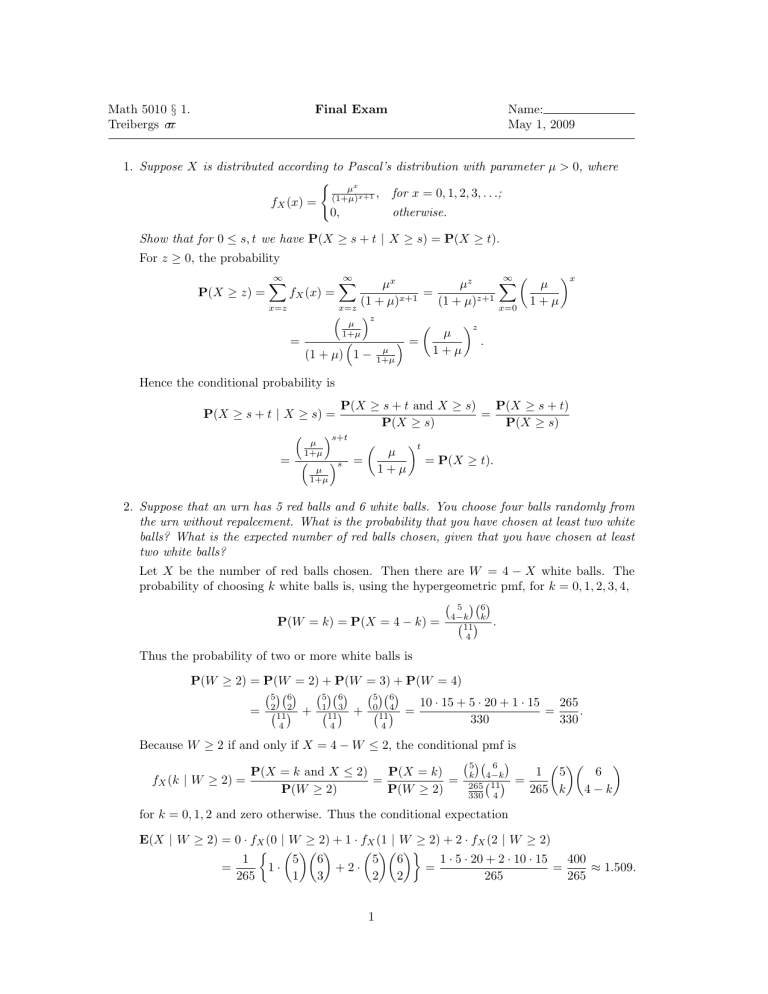
Math 5010 § 1.
Treibergs σ−
ιι
Final Exam
Name:
May 1, 2009
1. Suppose X is distributed according to Pascal’s distribution with parameter µ > 0, where
(
µx
(1+µ)x+1 , for x = 0, 1, 2, 3, . . .;
fX (x) =
0,
otherwise.
Show that for 0 ≤ s, t we have P(X ≥ s + t | X ≥ s) = P(X ≥ t).
For z ≥ 0, the probability
x
∞ X
µz
µ
µx
=
P(X ≥ z) =
fX (x) =
(1 + µ)x+1
(1 + µ)z+1 x=0 1 + µ
x=z
x=z
z
µ
z
1+µ
µ
=
=
.
1+µ
(1 + µ) 1 − µ
∞
X
∞
X
1+µ
Hence the conditional probability is
P(X ≥ s + t | X ≥ s) =
µ
1+µ
= P(X ≥ s + t and X ≥ s)
P(X ≥ s + t)
=
P(X ≥ s)
P(X ≥ s)
s+t
µ
1+µ
s =
µ
1+µ
t
= P(X ≥ t).
2. Suppose that an urn has 5 red balls and 6 white balls. You choose four balls randomly from
the urn without repalcement. What is the probability that you have chosen at least two white
balls? What is the expected number of red balls chosen, given that you have chosen at least
two white balls?
Let X be the number of red balls chosen. Then there are W = 4 − X white balls. The
probability of choosing k white balls is, using the hypergeometric pmf, for k = 0, 1, 2, 3, 4,
6
5
P(W = k) = P(X = 4 − k) =
4−k k
11
4
.
Thus the probability of two or more white balls is
P(W ≥ 2) = P(W = 2) + P(W = 3) + P(W = 4)
5 6
5 6
5 6
10 · 15 + 5 · 20 + 1 · 15
265
2 2
1 3
0 4
=
.
= 11 + 11 + 11 =
330
330
4
4
4
Because W ≥ 2 if and only if X = 4 − W ≤ 2, the conditional pmf is
6 5
P(X = k and X ≤ 2)
P(X = k)
1 5
6
k 4−k
fX (k | W ≥ 2) =
=
= 265 11 =
P(W ≥ 2)
P(W ≥ 2)
265 k
4−k
330 4
for k = 0, 1, 2 and zero otherwise. Thus the conditional expectation
E(X | W ≥ 2) = 0 · fX (0 | W ≥ 2) + 1 · fX (1 | W ≥ 2) + 2 · fX (2 | W ≥ 2)
1
5 6
5 6
1 · 5 · 20 + 2 · 10 · 15
400
=
1·
+2·
=
=
≈ 1.509.
265
1 3
2 2
265
265
1
3. Let X and Y be two independent
normal
random variables with zero means and variances
2
2
−X 2 2
σ and τ , resp. Find E e
Y
2
2
By independence, E e−X Y 2 = E e−X E Y 2 . Using the normal density for X,
−X 2
E e
1
= √
σ 2π
Z
∞
2
−x2
e
− x2
e 2σ dx =
−∞
2
− x2
c
e 2c dx =
σ
cσ 2π −∞
c
√
Z
∞
since the total probability of an N (0, c2 ) variable is one and where
1
1
=1+ 2
2
2c
2σ
so
c= √
σ
.
2σ 2 + 1
Also, since E(Y ) = 0 we have E(Y 2 ) = E(Y 2 ) − E(Y )2 = Var(T ) = τ 2 . Thus
2
τ2
E e−X Y 2 = √
.
2σ 2 − 1
4. Suppose you roll a standard die 1200 times.
(a) What is the exact probability that the number of sixes X satisfies 200 ≤ X ≤ 210?
(b) Approximate the probability. State carefully why you can make the approximation.
You can leave your answer in terms of the cumulative distribution function Φ(z) of the
standard normal variable.
Let X be the number of successes in n = 1200 independent trials with the probability of
success (rolling a six) is p = 61 . Thus X ∼ binomial(n = 1200, p = 16 ). Thus the exact
probability is
210
X
x 1200−x
210 X
1200
1
5
P(200 ≤ X ≤ 210) =
fX (x) =
.
6
6
x
x=200
x=200
By the de Moivre-Laplace Theorem, for fixed p, the standardized binomial variable converges
to the standard normal Z ∼ N (0, 1) in distribution as n → ∞. Assume that n is sufficiently
large that this approximation is valid. By the rule of thumb of Math 3070, npq = 1200· 61 · 56 =
1000
6 ≈ 166.7 which exceeds ten and the approximation is acceptable. The conclusion also
follows from the Central Limit Theorem. This time X = Sn = X1 + · · · + X2 where the
Xi ’s are IID Bernoulli variables with probability of success p = 16 . Thus all E(Xi ) = p,
Var(Xi ) = pq and the mgf is MXi (t) = q + pet which is defined for all t, thus in a
neighborhood ot t = 0. We have E(X) = np and Var(X) = npq. Both theorems imply for
all z ∈ R,
Sn − np
lim P
≤ z = P(Z ≤ z).
√
n→∞
npq
Assuming that for n = 1200 both values are close,
200 − np
X − np
210 − np
P(200 ≤ X ≤ 210) = P
≤ √
≤ √
√
npq
npq
npq
210 − 200
10
1
≈ P 0 ≤ Z ≤ q
= Φ q
− Φ(0) = Φ (0.775) −
2
1000
1000
6
6
which equals approx. 0.7807 − 0.5000 = 0.2807.
2
5. Suppose that X and Y be continuous variables whose joint density is defined on an infinte
wedge
(
e−x , if 0 < y < x < ∞;
f (x, y) =
0,
otherwise.
Find P(X ≤ 4 and Y ≤ 5). Find the marginal densities fX (x) and fY (y). Are X and Y
independent? Why? Find E(X).
The region {(x, y) ∈ R2 : x ≤ 4 and y ≤ 5} cuts a triangle from the wedge, hence since
5 > 4,
Z4 Zx
Z4
i4
h
= 1 − 5e−4 .
P(X ≤ 4 and Y ≤ 5) =
e−x dy dx =
x e−x dx = −xe−x − e−x
0
x=0 y=0
x=0
The marginals are for x, y ≥ 0,
Z ∞
Z
fX (x) =
f (x, y) dy =
y=−∞
∞
e−x dy = xe−x ;
y=0
∞
Z
fY (y) =
x
Z
f (x, y) dx =
x=−∞
h
i
e−x dx = −e−x
∞
= e−y .
y
x=y
X and Y are not independent, because, e.g., 0 = f (2, 3) 6= fX (2)fY (3) = 2e−5 .
Finally, X is distributed as a Gamma variable with λ = 1 and r = 2. Thus E(X) = rλ−1 =
2, as on p. 320. Or we integrate (by guessing the antiderivative)
Z ∞
h
i∞
E(X) =
x2 e−x dx = −(x2 + 2x + 2) e−x
= 2.
0
0
6. A continuous random variable has the cumulative
if
0,
FX (x) = ex − 1, if
1,
if
distribution
x ≤ 0;
0 < x < ln 2;
ln 2 ≤ x.
(a) Find the moment generating function MX (t). Where is it defined?
(b) Let Y = eX . Find the density fY (y).
The density function is
fX (x) =
0
FX
(x)
(
ex , if 0 < x < ln 2;
=
0, otherwise.
Thus the moment generating function is
MX (t) = E(etX ) =
Z
0
ln 2
ln 2,
if t = −1;
etx ex dx = e(1+t) ln 2 − 1
, if t 6= −1.
1+t
It is defined for all t ∈ R, since the integral is taken over a finite interval and is finite for
any t ∈ R. The cumulative distribution function of Y = eX is for e0 = 1 < y < 2 = eln 2 ,
FY (y) = P(Y ≤ y) = P(eX ≤ y) = P(X ≤ ln y) = FX (ln y),
so that
d
F 0 (ln y)
d
FY (y) =
FX (ln y) = X
=
fY (y) =
dy
dy
y
3
(
1, if 1 < y < 2;
0, otherwise.
7. Let X1 , X2 , X3 , . . . , Xn , . . . be a sequence of mutually independent random variables. Suppose that each Xn has the Laplace density with λ = 13 , i.e., with density function
f (x) =
1 −λ|x|
λe
for x ∈ R.
2
How big does n have to be so that
|X1 + X2 + · · · + Xn |
1
P
≥1 ≤
?
n
100
A random variable distributed according to the Laplace density has E(Xi ) = 0, since it’s
symmetric about zero. Its variance is Var(Xi ) = 2λ−2 = 18 (see, e.g., p. 320). If Sn =
X1 + X2 + · · · + Xn is a sum of independent variables then, by linearity and independence,
1
1
18
E
Sn = 0,
Var
Sn =
.
n
n
n
Applying Chebychov’s Inequality, for a rv Y and a > 0,
P(|Y − E(Y )| ≥ a) ≤
with Y =
1
n Sn
Var(Y )
,
a2
and a = 1,
P
1
Sn ≥ 1
n
≤
18
,
n
which is less than 0.01 if n ≥ 1800.
8. Ten married couples, (Mr. & Mrs. Able, Mr. & Mrs. Baker, Mr. & Mrs. Charles, &c. ) with
different last names play the following party game. All 20 people write their last name on a
slip of paper and put it into a hat. Then everyone takes one of the slips randomly from the
hat without replacement. Anyone who chooses their own name wins a prize. Let X be the
number of people who choose their own last name. Find E(X) and Var(X).
Number the people i = 1, 2, 3, . . . , 20. Let the indicator Ii = 1 if the ith person draws their
own last name and 0 otherwise. Observe that X = I1 + I2 + · · · + I20 is the number of
people who draw their own names. Then for the ith person, the number of correct names
divided by the number of slips is
E(Ii ) = P(ith person draws own name) =
Thus
E(X) = E
20
X
!
Ii
=
20
X
i=1
i=1
E(Ii ) = 20 ·
2
1
=
.
20
10
1
= 2.
10
To compute the variance, we need
"
Var(X) = E(X 2 ) − E(X)2 = E
20
X
#2
20 X
20
X
Ii − 4 =
E(Ii Ij ) − 4.
i=1
i=1 i=1
If i = j then Ii2 = Ii so E(Ii2 ) = E(Ii ) = 0.1. if i 6= j but i and j are spouses
E(Ii Ij ) = P(Ii = 1 and Ij = 1) = P(Ij = 1) P(Ii = 1 | Ij = 1) =
4
1 1
1
·
=
10 19
190
since the second person has only one remaining slip with their name on it. If i 6= k and i
and k are not spouses, then
E(Ii Ik ) = P(Ii = 1 and Ik = 1) = P(Ik = 1) P(Ii = 1 | Ik = 1) =
2
1 2
·
=
10 19
190
since there are two slips with k’s name left in the hat. Partitioning the sum,
X
X
X
E(X 2 ) =
E(Ii2 ) +
E(Ii Ij ) +
E(Ii Ik )
i
= 20 ·
i =
6 j, i and j
are spouses
i 6= k, i and k
are not spouses
1
1
2
380 + 20 + 720
112
+ 20 ·
+ 360 ·
=
=
10
190
190
190
19
Finally,
Var(X) = E(X 2 ) − E(X)2 =
5
112
36
−4=
.
19
19
